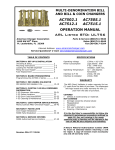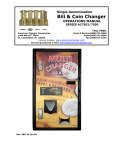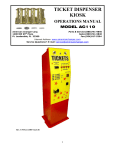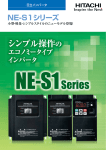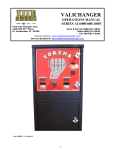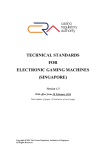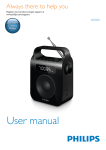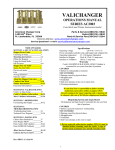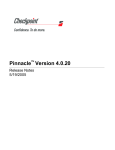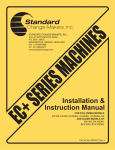Download Operations Manual - AECO Sales & Service
Transcript
MULTI-DENOMINATION BILL AND BILL & COIN CHANGERS AC7502.1 AC7512.1 AC7505.1 AC7515.1 OPERATION MANUAL ARL Listed STD: UL756 American Changer Corporation 1400 NW 65th Place Ft. Lauderdale, FL 33309 Parts & Service:(888)741-9840 Sales:(800)741-9840 Fax:(954)917-5204 Internet Address: www.americanchanger.com Service Questions? e-mail: [email protected] TABLE OF CONTENTS SPECIFICATIONS SECTION A: SET-UP & INSTALLATION Uncrating & Setup Mounting Instructions Loading the F53 Bill Dispenser Filling the Coin Hopper Fuse Replacement 2 2-3 3-4 5 5 SECTION B: BOARD PROGRAMMING Programming the AC7500.1 Series 6-14 SECTION C: MEI (MARS) VALIDATOR MEI AE2602 Bill Validator Info. 15-19 SECTION D: FUJITSU F-53 BILL DISPENSER INFORMATION 20-21 F-53 Dispenser Information 22 F-53 Sensor locations 23-32 F-53 Error Code Descriptions 33-35 F-53 Cleaning & Maintenance SECTION E: COIN HOPPER SERVICE MANUAL 36-42 Money Controls MKIV Universal Hopper SECTION F: PARTS LISTS Coin Hopper Breakdown MARS Parts Breakdown 43 44-46 SECTION G: SERVICE CENTERS MARS Authorized Service Centers 47-49 Revision 30A-27 7.28.06 Operating voltage Power Consumption Operating Temperature Interface to F-53 Interface to Validator 120Vac +10/-15% Logic Board: 10W F-53: 144W max. Validator: 50W max. 32 – 130 degrees Fahrenheit 24Vdc, RS-232 24Vdc, MDB WARRANTY The MEI (Mars) Validator is under warranty for two (2) years from the date of purchase. The dispensers and logic boards are under warranty for one (1) year from the date of purchase. COVERED • Defects in workmanship or materials NOT COVERED • Damage caused by physical abuse • Misapplication • Vandalism • End user’s attempt to repair item • Cleaning / Maintenance It is the End User’s responsibility to follow the cleaning & maintenance procedure outlined on page 18. Any unit coming in for repair requiring only a cleaning will be charged a flat rate of $65.00 plus shipping and handling. A Return Material Authorization number (RMA #) must be obtained before returning a unit for repair. A copy of invoices must accompany any and all warranty work. UNCRATING AND SETUP 9. NOTE: SECURING THE CHANGER USING LESS THAN ALL 4 HOLES MAY BE DANGEROUS. EACH HOLE NEEDS A BOLT THROUGH IT MOUNTED SECURELY TO THE WALL. MOUNTING THE CHANGER IN ANY OTHER WAY MAY RESULT IN THE CHANGER BEING TORN OFF OR FALLING OFF THE WALL, RESULTING IN PERSONAL OR CUSTOMER INJURY ALONG WITH ELECTRICAL SHOCK. 10. Choose a height to mount the changer, keeping in mind that a handicapped person in a wheelchair should still be able to insert a bill into the bill validator. (We recommend no higher than 4 feet above the ground.) 11. Have someone hold the changer against the wall while someone else marks the holes. CAUTION: THE CHANGER WEIGHS 125 POUNDS; DO NOT EXERT YOURSELF SO THAT YOU MAY CAUSE AN INJURY. 12. BEFORE DRILLING THE FOUR MARKED HOLES ENSURE THAT THERE ARE NO ELECTRICAL WIRES, TELEPHONE LINES, GAS, OR WATER LINES BEHIND THE WALL WHICH DISRUPTING MAY CAUSE PERSONAL INJURY OR LOSS OF LIFE! 13. Hold the changer back up to the wall. Thread and tighten bolts. 14. Verify that the machine is securely mounted, and reinstall the bill dispenser and coin hopper (model AC7502.1 only). Remove your AC7500 series dispenser from the shipping box. Take the Hex handle out of the manila envelope and open the door. The lock system is a screw-in type and, therefore, must be turned at least 10 times counter-clockwise until it opens. Inspect the interior for any connectors or components that may have been dislodged during shipping. The lock and keys for your MultiDenomination Changer will also be inside the manila envelope, along with this manual. To install the locks, insert a cylinder into the center of each of the round holes. Turn the keys counter-clockwise ¼ turn, and remove the keys. NOTE: The only way to get a duplicate set of keys made is to save the silver tag that comes between the keys. Write your Key ID# below for reference. ALL KEY ORDERS TAKE 4-6 WEEKS!!! MOUNTING THE AC7502.1/AC7512.1 TO A WALL IF YOU ARE UNSURE IN ANY WAY IN PROCEEDING WITH THE FOLLOWING STEPS, PLEASE HIRE A LOCAL PROFESSIONAL ELECTRICIAN TO MOUNT YOUR CHANGER FOR YOU! 1. Disconnect any and all AC power going into the AC7500 series changer. 2. Slide the bill dispenser and the coin hopper (model AC7502.1 only) out of the cabinet. 3. Note: You will need to verify with the building code that it is allowable to plug the changer into a 3 prong grounded wall outlet. Do not use an extension cord unless allowed by the building electrical code. If it is not, there must be 120VAC run through a conduit into the changer. If this is not required, proceed to step #6. 4. Let an electrician run the conduit, install the new breaker, run the wire, and help decide how the wiring will enter the changer (from the back or the bottom). This will affect the mounting location. 5. After the conduit has been installed, proceed with the mounting. 6. Locate the 4 punch-outs on the back wall of the changer. Using a screwdriver and hammer knock the punch-outs out by hitting them from the inside of the changer. 7. Using a stud finder, select a location to hang the changer by locating the wall studs. 8. Find an appropriate wall to bolt the changer into. The wall should have studs or be constructed of concrete. You may also be required to use a support brace under the changer. Consult a professional with any questions you may have. MOUNTING THE AC7505.1/AC7515.1 INTO A WALL IF YOU ARE UNSURE IN ANY WAY IN PROCEEDING WITH THE FOLLOWING STEPS, PLEASE HIRE A LOCAL PROFESSIONAL ELECTRICIAN TO MOUNT YOUR CHANGER FOR YOU! 1. Disconnect any and all AC power going into the AC7500 series changer. 2. Slide the bill dispenser and the coin hopper (model AC7505.1 only) out of the cabinet. 3. Note: You will need to verify with the building code that it is allowable to plug the changer into a 3 prong grounded wall outlet. Do not use an extension cord unless allowed by the building electrical code. If it is not, there must be 120VAC run through a conduit into the changer. If this is not required, proceed to step #6. 4. Let an electrician run the conduit, install the new breaker, run the wire, and help decide how the wiring will enter the changer (from the back or the bottom). This will affect the mounting location. 5. After the conduit has been installed, proceed with the mounting. 6. Find an appropriate wall to bolt the changer into. The wall should have studs or be constructed of concrete. Consult a 2 7. 8. 9. 10. 11. 12. 13. professional with any questions you may have. NOTE: SECURING THE CHANGER USING LESS THAN 4 BOLTS OR WELDED ANGLE IRON MAY BE DANGEROUS. EACH HOLE NEEDS A BOLT THROUGH IT MOUNTED SECURELY TO THE WALL. MOUNTING THE CHANGER IN ANY OTHER WAY MAY RESULT IN THE CHANGER BEING TORN OR FALLING OUT OF THE WALL, RESULTING IN PERSONAL OR CUSTOMER INJURY ALONG WITH ELECTRICAL SHOCK. Choose a height to mount the changer keeping in mind that a handicapped person in a wheelchair should still be able to insert a bill into the bill validator. (We recommend no higher than 4 feet above the ground). AC7505.1 and AC7515.1 changers have four holes in the bottom of the cabinet to be used for bolting it into the wall. Have someone hold the changer inside the wall while someone else marks the bolt holes. CAUTION: THE CHANGER WEIGHS 125 POUNDS; DO NOT EXERT YOURSELF SO THAT YOU MAY CAUSE AN INJURY. BEFORE DRILLING THE FOUR MARKED HOLES ENSURE THAT THERE ARE NO ELECTRICAL WIRES, TELEPHONE LINES, GAS, OR WATER LINES INSIDE THE WALL WHICH DISRUPTING MAY CAUSE A LOSS OF LIFE OR PERSONAL INJURY! Put the changer back into the wall. Thread and tighten the bolts. Verify that the machine is securely mounted, and reinstall the bill dispenser and coin hopper (model AC7505.1 only). 2. Push the button on the bottom right of an inserted cartridge to release it. Then, slide it straight forward, and out of the dispenser. 3. On the opposite side of the release button is another button that unlocks the top of the cartridge. Push it, and swing open the top. PRESSURE PLATE FRONT REAR GUIDE SIDE GUIDES 4. LOADING THE F53 BILL DISPENSER Different bill types are held in individual bill cartridges that are removable from the main dispenser body. Perform the following procedure to load bills into a cartridge, and ready the machine for use. 5. NOTE: “Street Grade” notes may be dispensed from this dispenser, but not necessarily “Tissue Paper” degraded notes. Please make sure ripped bills, taped bills, seriously worn bills, and/or crumpled bills are removed from the stack before loading! Bills that are folded in any way should be straightened before being loaded for the most trouble-free operation. 6. Loading Bills: 1. Turn off the power to the Main Logic Board using the rocker switch on the bottom right side (I = ON, O = OFF). 3 Lift open both the pressure plate and the rear guide, as seen in the figure above. The rear guide should just swing up, while the pressure plate should be slid straight up following the grooves on either side of it. Then, it should be rotated so it is held in place, at an angle, by the notches at the top of the grooves. Assemble the bills into a stack, and square them up by jogging and aligning them, tapping them against a flat surface, and removing any folded or crumpled bills. Load the bills into the cartridge so they fit snugly between the side guides. Then, lower the pressure plate and rear guide to hold the bills securely in place. Re-close the cartridge. NOTE: The cartridge holds a maximum of 500 bills; do not cram the bills or overfill the cartridge! a Exterior Interior Setting Bill Denominations: Inside each cartridge, there are four slots, a – d, and two magnets. The magnets are used to indicate the bill denomination loaded into each cartridge. Refer to the following table to determine the proper slots to put the magnets into when loading bills. c b d Magnets d b c a Bracket NOTE: The magnet positions are preset by American Changer, and do not need to be changed unless you wish to dispense a different denomination. To simply refill empty cartridges, use the table below to identify which cartridge to load which bill denomination into. Bill Denomination [ref.] Magnet Slot a b ● $1 [A] ● $5 [B] ● $10 [C] ● c 4. d ● ● $20 [D] ● $50 [E] ● $100 [F] ● ● ● ● To replace a magnet, locate the proper slot using the bill denomination table and the embossed letters on the exterior of the cartridge (a-d in the figure above). Insert a magnet into the slot with its white sides oriented as shown in the figure below, i.e. both white surfaces facing the exterior of the cartridge. NOTE: This is VERY IMPORTANT! The F53 may not properly recognize the bill denomination if the magnets are inserted the wrong way. Slide each magnet all the way into its slot, and then reattach the bracket, using the two screws, to hold them in place. • = Magnet in slot; “ ” = Slot empty 1. 2. 3. Remove a cartridge from the dispenser. Open the cartridge, and locate the four magnet slots along the inside front of the top. The two magnets are held in place inside their slots by an aluminum bracket. To remove a magnet, unscrew the two screws holding the aluminum bracket in place, and remove the bracket. Be careful not to lose the two nuts; they are small and not permanently connected to the cartridge (In case you do, the screw size is M3.5 x 6mm). Once the bracket is off, a magnet may be pulled out with your fingers, pried out with a small flathead screwdriver, or pushed out from the opposite side using any rod-shaped implement. White 4 White FILLING THE COIN HOPPER 4. Hopper Coin/Token Sizes: The standard MKIV hopper will automatically adjust to dispense coins/tokens ranging in size from 21-30 mm in diameter and 1.25-3.5 mm in thickness. There are options available to dispense larger, up to 31 mm, and smaller, down to 16 mm, coins or tokens. 5. 6. For reference, a nickel is 21.2 mm, a quarter is 24.3mm, and Susan B. Anthony and Sacagawea Dollars are 26.5mm in diameter. The Money Controls MKIV Universal Hopper can hold up to 1600 quarters ($400 worth) without a hopper extension. With the supplied American Changer hopper extension, an additional 1200 coins can be added, making the total 2800 quarters ($700 worth). The capacity for Dollar coins is 2200 Susan B. Anthony or Sacagawea dollars, with the extension, and 1250 coins without it. FUSE This is the primary High voltage fuse: transformer AC fuse for the main logic board, from which the validator and hopper (if installed) draw their power. Any direct short of the Transformer, validator, or hopper will cause this fuse to blow. Replace this fuse with a 2-½ Amp, 250 Volt, size 5mm x 20mm, fast-acting fuse only. REPLACING THIS FUSE WITH ANYTHING OTHER THAN A 2-½ AMP FASTACTING FUSE MAY RESULT IN A FIRE OR AN UNSAFE WORKING CONDITION!! Hopper Coin Bin (Pour the coins into this hole) Security LED ON = All systems OK Coin counting LED 12Vdc Power LED Coin counting optical sensor 12-pin male connector (Rear-Load; on Front-Load models, connector is on opposite side Slide the hopper back onto the hopper plate, making sure it goes all the way back. Do not use excessive force! Verify that the hopper plate harness is plugged in to the correct connector on the Main Logic Board for the coin/token value being used. The upper connector is for $1.00 coins, and the lower connector is for $0.25 coins. Turn ON the power switch. After approximately 30 seconds, when the machine has completed its start-up procedure, the changer will be ready to use. To change the amounts of coins dispensed, refer to the “Setting the Payouts” section of this manual. Motor Loading Coins/Tokens into the Hopper: 1. Turn off the power to the Main Logic Board using the rocker switch on the bottom right side (I = ON, O = OFF). 2. Remove the hopper from the cabinet by, first, sliding it free of the hopper plate, and then, lifting it out of the machine for access to the coin bin. 3. Pour the coins/tokens into the opening. NOTE: There must be at least enough coins in the hopper to cover the two gold-color metal plates at the bottom of the Hopper Coin Bin for the machine to work (Anywhere between 100 and 2800 coins, minimum to maximum with extension). 5 PROGRAMMING THE AC7500.1 SERIES CHANGER Section Page(s) Program Flow Chart 7-9 Standby Operation 10 Menu Navigation 10 Coin Hopper Setup 10 Bill Dispenser Setup 11 Dispenser Type 11 Low Bills Detection 11 Setting the Payouts 11-12 Using the Hopper ‘Dump’ Feature 12 Anti-Stringing Protection 12-13 System Diagnostics 13-14 Bill & Coin Counts 13 Ambient Temperature 14 Bill Cartridges 14 Board Firmware Version 14 Main Logic Board Command in Execution 14 Validator Command in Execution 14 Bill Dispenser (BDU) Command in Execution 14 Last Bill in Escrow 14 Last Change Payout 14 6 7 8 9 STANDBY OPERATION decreases a value; SEL (Select) is like a computer’s ‘Enter’ key in that it ‘enters’ the submenus (moves right on the Flow Chart), and saves values and selections to permanent memory; ESC (Escape) is used to go back one step to the previous menu (left on the Flow Chart). Power-ON the Main Logic Board (MLB), and allow it to run through its start-up procedure, which may take up to a minute. During this time, you may hear the bill dispenser and validator motors cycling as they are being initialized; this is normal. The board will reach its Standby state, ready to accept bills, once all motion has ceased, and all indicator lights are showing the following “Ready” conditions: 1. The MLB display’s green backlight will be ON continuously, and the screen will show the current count of total dollars changed by the machine (refer to the figure below). 2. The Bill Dispenser’s green seven-segment LED display will show a zero (0). 3. The validator’s red indicator LED will be ON solid. NOTE: Selecting any of the ‘Exit’ options located in various places throughout the program menus will take the display immediately back to the Standby state. The following sections of this manual describe the various features available on the board, and how to use them. The writing in parentheses at the beginning of paragraphs is the pushbutton sequences used to navigate to that specific program menu option. COIN HOPPER SETUP TOTAL $00000 (SELx2) HOPPERS: The ‘Hoppers’ menu is used to tell the controller board whether or not a hopper is going to be used, and if so, the value of the coins/tokens it contains to be dispensed. (SELx3) HOPPER #1: Press SELECT when the ‘Hopper #1’ menu option is displayed to set the value of the coins/tokens in Hopper #1. Hopper #1 is the hopper connected to the lower hopper connector on the left side of the board. Use the UP and DOWN buttons to modify the displayed value until it is as desired, and then press SELECT to save it into permanent memory. The possible coin/token values are 20 per $1 – 1 per $1, No Hopper, $0.01, and $0.25 - $20.00 in $0.25 increments. MENU NAVIGATION Navigation through the various program menus is done using the LCD screen and the four pushbuttons located directly below it as an interface. Various things can be accomplished within the program, including setting up the Coin Hopper(s) and Bill Dispenser, setting the payouts, and accessing accounting and other diagnostic information. NOTE: If there is no Hopper #1 being used, select ‘No Hopper’. (SELx3, ↑) HOPPER #2: Press SELECT when the ‘Hopper #2’ menu option is displayed to set the value of the coins/tokens in Hopper #2. Hopper #2 is the hopper connected to the upper hopper connector on the left side of the board. Use the UP and DOWN buttons to modify the displayed value until it is as desired, and then press SELECT to save it into permanent memory. The possible coin/token values are 20 per $1 – 1 per $1, No Hopper, $0.01, and $0.25 - $20.00 in $0.25 increments. To access the program menus, press any of the four pushbuttons while in the Standby state. These are, from left to right: UP, DOWN, SEL (Select), and ESC (Escape), and they can be seen in the above figure. The first menu option that appears is the ‘Setup’ menu. Use either the UP and DOWN pushbuttons to move to a different menu option, or press SELECT to enter the ‘Setup’ menu. Pressing ESCAPE will take you back to the Standby state. At this point, it will be very helpful to follow along in the Program Flow Chart on pgs. 7-9 as you navigate through the program menus. The four pushbuttons’ functions remain the same throughout the program menus. These are: UP moves to the next menu item above the current one, or increases a value; DOWN moves to the next menu item below the current one, or NOTE: If there is no Hopper #2 being used, select ‘No Hopper’. 10 BILL DISPENSER SETUP pushbutton down to increase or decrease the count rapidly. (SELx2, ↑) DISPENSER: Enter the ‘Dispenser’ menu to make settings that involve the bill dispenser. These include the type of bill dispenser being used, the bill denomination to be dispensed (F50 only), the low-bills detection method to be employed, and the number(s) of bills currently loaded in the bill dispenser, by denomination. When the desired count has been reached, press SELECT to save the count into the board’s permanent memory, and move to the next bill denomination. The denominations appear in order: $1, $5, $10, $20, $50, and $100. You only need to set the counts of the bill denomination(s) you will be dispensing, and you may ignore the rest. Press SELECT to move through any counts not needed. (SELx2, ↑, SEL) DISPENSER TYPE: Press SELECT when the ‘Type’ menu option is displayed to set the type of bill dispenser to be used. Use the UP and DOWN pushbuttons to scroll between the different bill dispenser options, which are F53, and F50 w/ $1 bills – F50 w/ $100 bills. When the desired bill dispenser is displayed, press SELECT to save it into permanent memory. The advantage of the ‘Counts’ method is the low number of bills remaining when the machine goes out-of-service. Since the board maintains an exact count of bills remaining, it will only go out-of-service when there are not enough to make a single payout. Thus, depending on the set payout, typically fewer than 10, but as few as zero, bills may be left inside of the dispenser. The disadvantage of the ‘Counts’ method is that the bill quantities must be manually entered into the controller board each time the machine is refilled. NOTE: If using an F50, select the option that shows the bill denomination you are going to dispense. The F53 bill denominations are automatically detected. NOTE: When using the ‘Counts’ low-bills detection method, be careful to enter the exact quantity of bills in the dispenser. Incorrect count entries may lead to high numbers of bills remaining inside the dispenser when the machine goes out-of-service, or, worse, incomplete payouts to customers! (SELx2, ↑, SEL, ↑) LOW BILLS DETECTION METHOD: Press SELECT when the ‘Low Bills’ menu option is being displayed to set the method that the controller board will use to determine when there is a low number of bills remaining in the dispenser. The board can either use the built-in sensors inside of the dispenser, or keep track of the exact count of remaining bills, updating it continuously as bills are dispensed. There are pros and cons to both methods, which are described in the following sections. SETTING THE PAYOUTS (SEL, ↑) PAYOUT: Since each input bill denomination has its own unique payout setting, pressing SELECT while the ‘Payout’ menu option is being displayed will enter a menu where each of them are listed. Once inside this menu, use the UP and DOWN pushbuttons to scroll through the input bill denominations, which begin with $1, and increase through $2, $5, $10, $20, $50, and up to $100. Navigate through the menu until the desired input bill denomination is being displayed, and then press SELECT. (SELx2, ↑, SEL, ↑, SEL) SENSORS: While the ‘Sensors’ menu option is displayed, press SELECT to utilize the bill dispenser’s sensors to detect when the bills are low. The sensors are optical, and simply detect the size of the remaining stack of bills. The advantage of this method is its simplicity, because the bill counts do not have to be manually entered into the board. The disadvantage is that many bills, up to 40 or more, remain inside of the dispenser (F50) or its cartridges (F53) when the sensors detect “low bills”, and send the machine out-ofservice. The first setting to be made is whether the board will accept or reject the selected input bill denomination. Use the UP and DOWN buttons to scroll through the options ‘Accept’, ‘Reject’, and ‘Exit’, and then press SELECT to save the displayed choice into permanent memory. (SELx2, ↑, SEL, ↑, SEL, ↑) COUNTS: Press SELECT and enter the ‘Counts’ menu to have the controller board keep track of the remaining bills quantities to know when they run low. Once ‘Counts’ has been selected, the display will go immediately to the ‘$1:’ screen, where the $1 bills count can be entered. Use the UP and DOWN pushbuttons to increase or decrease the count on the screen to the exact quantity of $1 bills that are currently loaded in the dispenser. If ‘Accept’ is chosen, the next step is to set the desired bill/coin payout combination for the currently selected input bill denomination. The first payout option to be displayed is the quantity of coins/tokens to be dispensed from Hopper #1. The LCD screen should look like the following figure, with “HOP1:” at the bottom indicating Hopper #1, and “000” beside it indicating the quantity of coins/tokens to be dispensed. NOTE: Each press of the pushbutton increments or decrements the count by one. Hold the 11 USING THE HOPPER ‘DUMP’ FEATURE (SEL, ↑x2) DUMP: Press SELECT to enter the ‘Dump’ menu if you would like to empty the coin hopper(s). Coin “dumping” is a convenient method of emptying all of the coins/tokens from a hopper without having to remove the hopper from the machine. Also, since the Main Logic Board is controlling the operation, the coins are counted as they are dispensed, so the user will know exactly how many were left inside the hopper. Σ=000.00 HOP1:XXX (SEL, ↑x2, SEL) HOPPER #1: Navigate to this menu, ‘Hopper #1’, to dump the coins/tokens from Hopper #1. Press SELECT to initiate the dispensing, and display the coin count on the LCD screen. The hopper will run until it is completely empty, and will turn OFF automatically, with the final count remaining on the display. To stop the coin dump at any time before the hopper is empty, press the SELECT pushbutton. The count displayed will be the number of coins dispensed up to that point. Press ESCAPE to exit out of the hopper ‘Dump’ feature. Use the UP and DOWN pushbuttons to increase or decrease the number shown until it is the desired quantity. NOTE: If no Hopper #1 is installed, the payout quantity “000” will change to “XXX”, and pressing UP or DOWN will have no effect (refer to the above figure). Press SELECT to save the Hopper #1 payout quantity into permanent memory and move to the next payout option, Hopper #2. The Hopper #2 payout quantity should be set in the same manner, followed by the $1 bill payout quantity, then the $5, and $10, and so on. (SEL, ↑x2, SEL, ↑) HOPPER #2: Navigate to this menu, ‘Hopper #2’, to dump the coins/tokens from Hopper #2. Press SELECT to initiate the dispensing, and display the coin count on the LCD screen. The hopper will run until it is completely empty, and will turn OFF automatically, with the final count remaining on the display. To stop the coin dump at any time before the hopper is empty, press the SELECT pushbutton. The count displayed will be the number of coins dispensed up to that point. Press ESCAPE to exit out of the hopper ‘Dump’ feature. NOTE: Only bill denominations that are less than the currently selected input bill denomination will show up as payout options. For example, $5 bills will only show up as a payout option for $10 and higher input bill denominations. The top line of the LCD screen displays a running total (Σ = sum) of the bill/coin payout combination for the currently selected input bill denomination. This total is based on the bill/coin payout quantities and their values, and is updated when SELECT is pressed. ANTI-STRINGING PROTECTION “Stringing” refers to a method of defrauding any machine that uses a bill validator using string or tape attached to the end of a bill. The bill is inserted into the machine, and is yanked back out using the string or tape attachment after the validator has credited the money. This results in the thief getting the bill back, in addition to the change or other item(s) dispensed by the machine. The board’s Anti-Stringing Protection feature will not totally prevent the machine from getting “strung”, rather it is a method of limiting the amount of money and/or tokens the thief is able to steal. After the last payout option has been saved by pressing SELECT, the display should return to the list of input bill denominations so another payout can be immediately set. If it doesn’t, and the display returns, instead, to the Hopper #1 payout setting, there is a problem with one or more of the payout quantities just set. Notice that the total (Σ) at the top of the screen does not add up to the current input bill denomination; this will give you a clue as to which setting is at fault. If an input bill denomination is to be rejected, pressing SELECT while ‘Reject’ is being displayed will save that information into permanent memory, and return the display to the input bill denomination list. To exit from this list, either scroll and choose ‘Exit’, or press the ESCAPE pushbutton twice. (SEL, ↑x3) STRING: Press the SELECT pushbutton and enter the ‘String’ menu to either enable or disable the AntiStringing Protection feature. 12 (SEL, ↑x3, SEL) ANTI-STRINGING SETUP: Immediately inside of the ‘String’ menu, the first option displayed is ‘Yes’. Press SELECT with ‘Yes’ displayed to enable the Anti-Stringing Protection feature, and to make the settings that control the behavior of the protection. with $1, and progressing through $2, $5, $10, $20, $50, and up to $100. When finished, press ESCAPE to exit the list. ↑x4, SELx2, ↑) BILLS/COINS (SEL, DISPENSED: When the ‘Dispensed’ menu option is displayed, press SELECT to view the amounts of bills and coins dispensed by the machine. Use the UP and DOWN pushbuttons to scroll through each count, starting with Hopper #1, and progressing through Hopper #2, $1, $5, $10, $20, $50, and up to $100. When finished, press ESCAPE to exit the list. The first setting is the Maximum Dollar Amount setting. This option establishes the maximum dollar amount that can be accepted by the machine within the user-set time limit (next setting) before triggering the Anti-Stringing Protection, which puts the machine out-ofservice. The dollar amount can be set anywhere between $5 and $500 in $5 increments. Press SELECT to save the amount into permanent memory and continue to the second setting. NOTE: The hopper counts are in dollar units, not actual quantities. For example, if a hopper containing quarters shows a count of “3”, this means that $3.00, or 12 quarters, have been dispensed. The bill counts, on the other hand are actual quantities. The second, and final, setting is the Maximum Time setting. Entered here is the time limit for the changer accepting the user-set Maximum Dollar Amount (previous setting). If the changer accepts the Maximum Dollar Amount within the amount of time set here, the Anti-Stringing Protection feature will be triggered, and the machine will go out of service. The Maximum Time can be set to anywhere between 1 and 120 minutes in 1 minute increments. Press SELECT to save the time into permanent memory and return to the Standby screen. (SEL, ↑x4, SELx2, ↑x2) BILLS REJECTED: When the ‘Rejected’ menu option is displayed, press SELECT to view the quantities of bills rejected by the dispenser. Bills are rejected by the F50 or F53 bill dispensers for various reasons, including being crumpled, folded, or torn. These bills remain inside of the dispenser in a special compartment. Use the UP and DOWN pushbuttons to scroll through each bill denomination and its rejected count, starting with $1, and progressing through $5, $10, $20, $50, and up to $100. When finished, press ESCAPE to exit the list. (SEL, ↑x3, SEL, ↑) DISABLE PROTECTION: Navigate to this menu, ‘No’, and press the SELECT pushbutton to disable the Anti-Stringing Protection feature. The display will return to the Standby state, and the machine will operate normally. (SEL, ↑x4, SELx2, ↑x3) BILLS/COINS REMAINING: When the ‘Remaining’ menu option is displayed, press SELECT to view the quantities of bills and coins remaining in the machine. Use the UP and DOWN pushbuttons to scroll through each count, starting with Hopper #1, and progressing through Hopper #2, $1, $5, $10, $20, $50, and up to $100. When finished, press ESCAPE to exit the list. SYSTEM DIAGNOSTICS (SEL, ↑x4) DIAGNOSTICS: Enter the ‘Diagnostics’ menu to view various information about the board’s current state of operation. The most important submenu inside the ‘Diagnostics’ menu is the ‘Counts’ submenu. There, all of the counts maintained by the Main Logic Board, including the received, dispensed, rejected, and remaining counts, may be viewed. The other submenus contain assorted diagnostic information, as described in the following paragraphs, designed for use in troubleshooting. NOTE: The hopper counts do not list actual quantities, they only show either ‘OK’ or ‘LOW’, indicating the hopper has enough coins/tokens remaining or is running low, respectively. The bill counts, on the other hand are actual quantities. (SEL, ↑x4, SELx2, ↑x4) RESET COUNTS: Enter the ‘Reset’ menu option to reset three of the Logic Board’s four counts to zero. These are the received, dispensed, and rejected counts. (SEL, ↑x4, SEL) COUNTS: Press SELECT when the ‘Counts’ menu option is being displayed to view the board’s various counts. The counts may only be viewed inside the ‘Counts’ menu, and not modified, except to reset them to zero. (SEL, ↑x4, SELx2) BILLS RECEIVED: When the ‘Received’ menu option is displayed, press SELECT to view the quantities of bills received by the machine. Use the UP and DOWN pushbuttons to scroll through each bill denomination and its received count, starting NOTE: The bills remaining counts cannot be reset to zero here, they can only be modified in the ‘Setup’ menu. 13 Use the UP and DOWN pushbuttons to scroll between the two options, ‘Yes’ or ‘No’. Press SELECT when ‘Yes’ is displayed to reset the (SEL, ↑x4, SEL, ↑x6) BILL DISPENSER (BDU) COMMAND IN EXECUTION: Enter the program menu option ‘BDU CMD’ to view the current Bill Dispenser command in execution. The display shows the command, which is the specific operation or function that the Bill Dispenser is performing, on the top line above a time-out period, in seconds, on the bottom. received, dispensed, and rejected counts to zero, or when ‘No’ is displayed to return to the ‘Diagnostics’ menu without resetting the counts. (SEL, ↑x4, SEL, ↑) AMBIENT TEMPERATURE: Press SELECT when ‘Temp’ is being displayed on the LCD screen to view the current ambient temperature inside the cabinet. The temperature will be displayed in degrees Celsius (°C). To convert degrees Celsius to degrees Fahrenheit (°F), multiply the Celsius number by 1.8, and then add 32. (SEL, ↑x4, SEL, ↑x7) LAST BILL IN ESCROW: Press SELECT while the ‘Escrow’ menu option is being displayed to view the denomination of the bill most recently in the escrow position inside of the validator. The escrow position is fully inside the validator, but not yet stacked. A bill gets held in this position while the controller board decides whether to accept or reject it. (SEL, ↑x4, SEL, ↑x2) BILL CARTRIDGES: Navigate to the ‘F53’ menu option inside of the ‘Diagnostics’ menu, and press SELECT to view the bill denominations currently loaded in the bill dispenser. The denominations are listed by ‘Cassette’ (cartridge) number, with #1 being the upper and #2 being the lower bill cartridge of the F53 dispenser. Use the UP and DOWN pushbuttons to scroll between ‘Cassette’ numbers. (SEL, ↑x4, SEL, ↑x8) LAST CHANGE PAYOUT: While ‘Change’ is being displayed on the LCD screen, press SELECT to view the bill/coin combination that made up the most recent payout. Use the UP and DOWN pushbuttons to scroll through the list of possible payout options, beginning with Hopper #1. The hopper numbers, or bill denominations, are displayed beside the quantity of bills/coins of that type that made up the payout. The other payout options include Hopper #2, $1, $5, $10, $20, $50, and $100 bills. NOTE: Although most F53 dispensers have only two bill cartridges, more are possible, so the board was designed with the capability of controlling an F53 with up to four bill cartridges. In the case of an F50 dispenser, its single bill denomination is listed in ‘Cassette #1’. (SEL, ↑x4, SEL, ↑x3) FIRMWARE VERSION: Enter the program menu option ‘Version’ to view the board’s current firmware version. The firmware version is also displayed momentarily when the board power is turned on. ---[END PROGRAMMING SECTION]--- (SEL, ↑x4, SEL, ↑x4) MAIN LOGIC BOARD COMMAND IN EXECUTION: Enter the program menu option ‘MLB CMD’ to view the current Main Logic Board command in execution. The display shows the command, which is the specific operation or function that the MLB is performing, on the top line above a time-out period, in seconds, on the bottom. (SEL, ↑x4, SEL, ↑x5) VALIDATOR COMMAND IN EXECUTION: Enter the program menu option ‘VAL CMD’ to view the current Validator command in execution. The display shows the command, which is the specific operation or function that the Validator is performing, on the top line above a time-out period, in seconds, on the bottom. 14 MARS AE2602 MEI MARS AE2602 VALIDATOR SECTION PAGE BILL ACCEPTOR 24VDC $1-$20 15 Removing the Bill Box 16 Clearing a bill jam 16 Setting the bill types accepted 17 Cleaning & Maintenance 18 Troubleshooting & Error Codes 19 Removing the bill box 1. Push BLUE button forward. 2. Push bill box up and out. Clearing A Bill Jam 1. Pull up on silver bar (Rod) 2. Pull bar away from the Mars. 16 Setting the DIP Switches FACTORY DEFAULT IS ALL SWITCHES SET TO “OFF”! (SETTINGS MARKED BY X’s) X X 17 Cleaning Cleaning & Maintenance You can clean the bill acceptor while it is still mounted in the machine. 1. Remove power from the machine. 2. Unlatch the magazine by pushing the blue latch (located on the top of the unit) toward the front of the unit. 3. Unhook and remove the magazine by holding the latch and lifting up and then back on the magazine. 4. Unlatch the LED Housing by lifting up on the metal bar (located below the Status LED). 5. Remove the LED Housing by holding the metal bar and pulling back on the LED Housing. 6. Clean the bill path with a soft cloth. You may use mild, non-abrasive, non-petroleum based cleaners if sprayed on the cloth. 18 Status LED A Status LED provides assistance in diagnosing the condition of the Series AE2600. The following is a description of the LED codes, their meanings, and suggested remedial actions. 19 FUJITSU F-53 DISPENSER SECTION driven 20 (2) This picture shows the F53 Spray-Type top unit of a Front Load changer (AC7502.1, AC7512.1). The dispenser inside Rear Load changers (AC7505.1, AC7515.1) feeds the bills out of a Release outlet that is situated on the opposite side of the one shown. 21 SENSOR DIAGRAM Sensor Descriptions Cassette 1 BPS: Bill Pass Sensor (Dispensed bills) REJS: Rejected Bills Sensor DFSS: Gate Switch Timing Sensor DFCS: Double Feed Check Sensor (Bill thickness detection) FDLS1-6: Denominations 1-6 Length Detection Sensor Cassette 2 Cassette 3~6 (Option on F53) 22 NES1-6: Denominations 1-6 Near-End Sensor (Low bills detection) SET1-6: Magnet Settings Detection Sensor (Cartridge bill type) ERROR CODES Error Codes from the F53 bill dispenser are presented on the green LED character display located on the lower right-hand corner of the dispenser’s PC Board (refer to figure on page 33). 3RD Character 4TH Character 5TH Character 6TH Character (1) All error codes are a sequence of 6 characters that are displayed, in order, for approximately 1 second each. Error codes always begin with “Er” as the first two characters. (2) The third character shows the position in which the error occurred, the fourth character shows more detailed information about the error, and the fifth and sixth characters give any additional information. (3) The tables on the following pages define all of the possible error codes on the F53. EXAMPLE: For the error “2nd Cassette Pick Error”, the display will flash: repeatedly; one second per character. 23 “E-r-2-8-0-0” 24 25 26 27 28 29 30 31 32 LED Character Display 33 ROUTINE CLEANING & MAINTENANCE YEARLY Belts: Inspect whether the bill-carrying flat belts have become loose due to expansion, or are worn, cracked, or damaged in any way. If so, replace them with new belts. Cartridge Pick/Sub Rollers: Inspect the Pick and Sub Rollers in each bill cartridge. If they are worn, damaged, or have difficulty pulling bills out of the cartridge, replace them with new rollers. EVERY FOUR MONTHS (OR WHEN NEEDED) Bill Thickness Detection Lever: Check whether paper dust, or other dirt and grime has adhered to the thickness detection lever, or its attached metal rollers. Clean both sides of the lever and the rollers with a soft dry cloth. Sensors: Inspect all of the F53’s optical sensors for dirt, dust, or any other grime that could lead to impaired operation. Gently clean the sensors using ONLY a soft, dry, and lint-free cloth. Belts and Rollers: Clean all of the machine’s belts and rollers, paying close attention to the bill-carrying belts and the Pick and Sub Rollers in each bill cartridge. Remove any dirt and grease from them using a soft, lint-free cloth soaked in isopropyl alcohol. 34 35 MKIV UNIVERSAL HOPPER INDEX PAGE 1. Coin box removal & assembly SERVICE MANUAL 36 37-38 2. Exit window replacement 38 3. Logic board replacement 39 4. End plate removal 39 5. Track plate removal 39 5a. Track plate Assembly 40 5b. Track plate Replacement 41 5c. Final drive gear replacement 41 6. Gearbox assembly 42 7. 7. Motor replacement 42 To UN-jam the hopper, refer to sections 4 – 5b, pages 39–41. 6. 1. COIN BOX REMOVAL 1. Place the hopper in front of you as shown, (looking at the outside of the ‘coin box’). As the ‘coin box’ is being removed, carefully slide the ‘logic board’ out. The stirrer may stay with the ‘coin box’ or fall onto the center plate. Refer to FIG 1. 2. Remove the 2 locking nuts, which hold the ‘low level sense plate’ wires to the studs. 3. Remove the crimp & wire from the studs. ACCESS IS NOW AVAILABLE TO THE ‘LOW LEVEL’ SENSE PLATES, THE MAIN PCB, THE EXIT WINDOW, THE MOTOR TERMINALS & PART OF THE WIRING LOOM. Refer to FIG 1a. 4. Remove the 5 screws indicated (B), which hold the ‘coin box’ to the ‘center plate’. 5. Gently lift the ‘coin box’ away from the rest of the hopper. (Refer to FIG 1b) 1a. COIN BOX ASSEMBLY 1. NOTE: The ‘logic board’ & ‘stirrer’ are located in the ‘coin box’. 37 Firstly, locate the ‘stirrer in the ‘coin box as shown in FIG 12. COIN BOX ASSEMBLY (cont.) 2. Line up the ‘center plate’ & ‘coin box’ as shown below. FIG 12a. 3. Route the ribbon cable as shown below. 4. Fit the ‘logic board’ into slots shown below. 5. Feed the level sense wires through the slot shown below. 7. 8. 9. Align the ‘center plate’ & ‘coin box’ & push together. Turn the hopper over & refit the screws. Refit the level sense wires. 2. EXIT WINDOW REPLACEMENT 1. First, remove the ‘coin box’, section 1. This will then enable access to the ‘exit window’ 2. Unscrew & remove the 2 fixing screws. (See FIG 4) 3. Remove the ‘exit window’ from the ‘center plate’. 4. Unclip & remove the 10-way ribbon cable header. 6. Lift the ‘centre plate’ to meet the ‘coin box’. FIG 12b & c. 5. 38 To re-assemble, follow the above steps in reverse. 3. LOGIC BOARD REPLACEMENT 1. 4. Holding the ‘connector blanking plate’ gently lift the ‘end plate’ away from the rest of the hopper. 5. To re-assemble, follow the above steps in reverse. First, remove the ‘coin box’, section 1. This will then enable access to the ‘logic board’. 5. TRACK PLATE REMOVAL 1. 2. 3. 4. 5. 6. 7. 8. See FIG 7. 10-way ribbon IDC socket (CONN 1): Move the two ejector arms at right angles to & away from the connector, if fitted. This should release the socket from the header. Clasping the connector between thumb & forefinger, pull away from pin header. 2. 14-way crimp socket (CONN 2): Gently unclip the “friction lock” from the connector housing. Clasping the connector between thumb & forefinger, pull away from pin header. The Logic Board is now released. To re-assemble, follow the above steps in reverse. 4. END PLATE REMOVAL 1. Place the hopper in front of you as shown, (looking at the outside of the ‘end plate’). Refer to FIG 6. 2. Remove the 9 screws indicated (B), which hold the ‘end plate’ to the ‘center plate’. 3. Locate the position of the ‘connector blanking piece’. First, remove the ‘end plate’, section 4. 39 The ‘elevator track’ & ‘final drive gear’ can now be removed by lifting up & away from the ‘center plate’. 5a. TRACK PLATE ASSEMBLY The following 3 sketches show how to take the ‘track plate’ apart. The following 3 sketches show how to assemble the ‘track plate’. 40 5b. TRACK PLATE REPLACEMENT 1. The gray shaded area, in FIG 7b, is the ‘track plate’ guide path. FIG 7b. 2. Once the ‘track plate’ is in position, turn the track through 720 0 to ensure it is seated in the guide path correctly. 5c. FINAL DRIVE GEAR REPLACEMENT 1. 2. Once the ‘elevator track’ is in place, the ‘final drive gear’ can be fitted by placing the gear over its mounting spindle, while lining the teeth up with the secondary drive gear, adjust the ‘elevator track’ so that the gear falls into place. (See FIG 7c) The end plate can now be re-fitted. See section 4. 41 4. 6. GEAR BOX ASSEMBLY 1. Remove the end plate. Section 4. 2. Remove the ‘elevator track’ & ‘final drive gear’. Section 5. 3. Remove the gearbox cover. Access to the motor fixing screws is now possible. 7. MOTOR REPLACEMENT 1. Remove the ‘coin box’. Section 1. 2. Unsolder the red & black wires from the motor. NOTE: The black wire connects to the terminal marked with a RED dot. 3. Remove the ‘end plate’. Section 4. 4. Remove the ‘track plate’ & final drive gear. Section 5 5. Remove the gearbox cover. 6. Disassemble the gearbox. Section 6. Remove the gears in the order as shown in FIG 9. 42 5. To re-assemble, follow the above steps in reverse. 7. Unscrew the 2 motor fixing screws. FIG 10. 8. To re-assemble, follow the above steps in reverse. #1 - 1041-24-01 Motor #2 - 1041-24-02 Motor Side Cover #3 - 1041-24-03 Center Plate #4 - 1041-24-04 End Plate #5A- 1041-24-05 Coin Optic Board. #5B- 1041-24-06 Optic ribbon cable. #6 - 1041-24-07 Red track plates (16 per belt) #7 - 1041-24-08 Logic board wire harness #8 - 1040-24-113 Male 12 pin connector #9 - 1040-24-112 Female 12 pin connector #10 - 1041-24-12 Idler gear #11 - 1041-24-13 Gear Box #12 - 1041-24-14 Gear Shaft #13 - 1041-24-15 Gear #1 Plastic #14 - 1041-24-16 Gear #2 & 3 #15 - 1041-24-17 Output gear #16 - 1041-24-18 Gear #4 #17 - 1040-24-22 Blanking Plate #18 - 1040-24-25 Fixing screw #19 - 1041-24-19 Cam Shaft 1041-24-22 Agitator 1041-24-20 Cam shaft bearing #20 -1041-24-21 Cam Agitator #21 – 1040-24-36 Stirrer #22 - 1040-24-291 Low level contact plate. #23 - 1041-27-373 Mark IV PC logic board. #8 #2 #3 #5A #4 #6 #21 #18 #5B #18 #10 #19 #14 #20 #12 #11 #17 #23 #13 #1 #16 #7 #15 43 #22 MARS AE2600 SERIES 24VDC PARTS BREAKDOWN #8 PICTURE # #1 #2 #3 #4 #5 #6 #7 #8 #9 PART # AE93-1-1 AE93-1-2 AE93-1-3 AE91-1-4 AE93-1-5 AC1045 AE93-1-7 AE93-1-8 AE93-1-9 44 CONTINUED PICTURE # #1 #2 #3 #4 #5 #6 #7 #8 PART # AE93-2-1 AE93-2-2 AE93-2-3 AE93-2-4 AE93-2-5 AE93-2-6 AE93-2-7 AE93-2-8 DESCRIPTION Gearbox Assy Tension Assy Tension Spring Tire/Wheel Assy Belt, Timing, (1 of 2)-143 Teeth Pulley, Compound Shaft, Pulley Belt, Timing, (1 of 2)-56 Teeth 45 CONTINUED PICTURE # #1 #2 #3 #4 PART # AE93-1-5 AE93-3-2 AE93-3-3 AE93-3-3 DESCRIPTION Main Chassis, Plastic Stacker Latch, Blue Spring, Stacker Latch Lower Housing Lift Spring 46














































